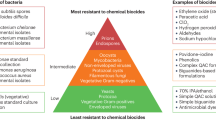Abstract
THE following bactericidal substances—trypaflavine (5 × 10-4 M), methylene blue (1 × 10-3 M), protamine sulphate (2.5 × 10-4 M), chinine (2·5 × 10-3 M) and crystal violet (1 × 10-4 M)—cause a strong and progressive inhibition of the respiration of bakers' yeast, suspended in glucose phosphate at 28° C. (cf. also ref. 1). Spermine and streptomycin, though also basic substances, even at high concentrations (1 × 10-2 M and 1 × 10-2 M respectively) do not affect the respiration of yeast and thus have no direct bactericidal activity. It can be shown that all these substances, the inhibitors as well as spermine and streptomycine, compete for the same negative components of the yeast cell, when brought in contact with a yeast suspension2.
This is a preview of subscription content, access via your institution
Access options
Subscribe to this journal
Receive 51 print issues and online access
$199.00 per year
only $3.90 per issue
Buy this article
- Purchase on SpringerLink
- Instant access to full article PDF
Prices may be subject to local taxes which are calculated during checkout
Similar content being viewed by others
References
Massart, L., Peeters, G., De Ley, J., and Vercauteren, R., Experimentia, 3, 119 (1947). De Ley, J., Peeters, G., and Massart, L., Biochim. et Biophys. Acta, 1, 393 (1947).
Massart, L., Peeters, G., and Van Houcke, A., Experientia, 3, 289 (1947).
Dubos, P., "The Bacterial Cell", 288 (Harvard University Press, 1947).
Michaelis, L., Cold Spring Harbor Symposia, 10, 131 (1947).
Silverman, M., and Evans, E. A., jun., J. Biol. Chem., 150, 267 (1943).
Author information
Authors and Affiliations
Rights and permissions
About this article
Cite this article
MASSART, L. Antagonism between Basic Compounds (Spermine, Streptomycin) and Basic Bactericidal Substances. Nature 162, 779 (1948). https://doi.org/10.1038/162779a0
Issue date:
DOI: https://doi.org/10.1038/162779a0
This article is cited by
-
Spermine as a Protective Agent against Osmotic Lysis
Nature (1959)
-
Antagonism between Trypaflavine and Cations
Nature (1950)
-
Mode of Action of Basic Antibacterial Substances
Nature (1949)



